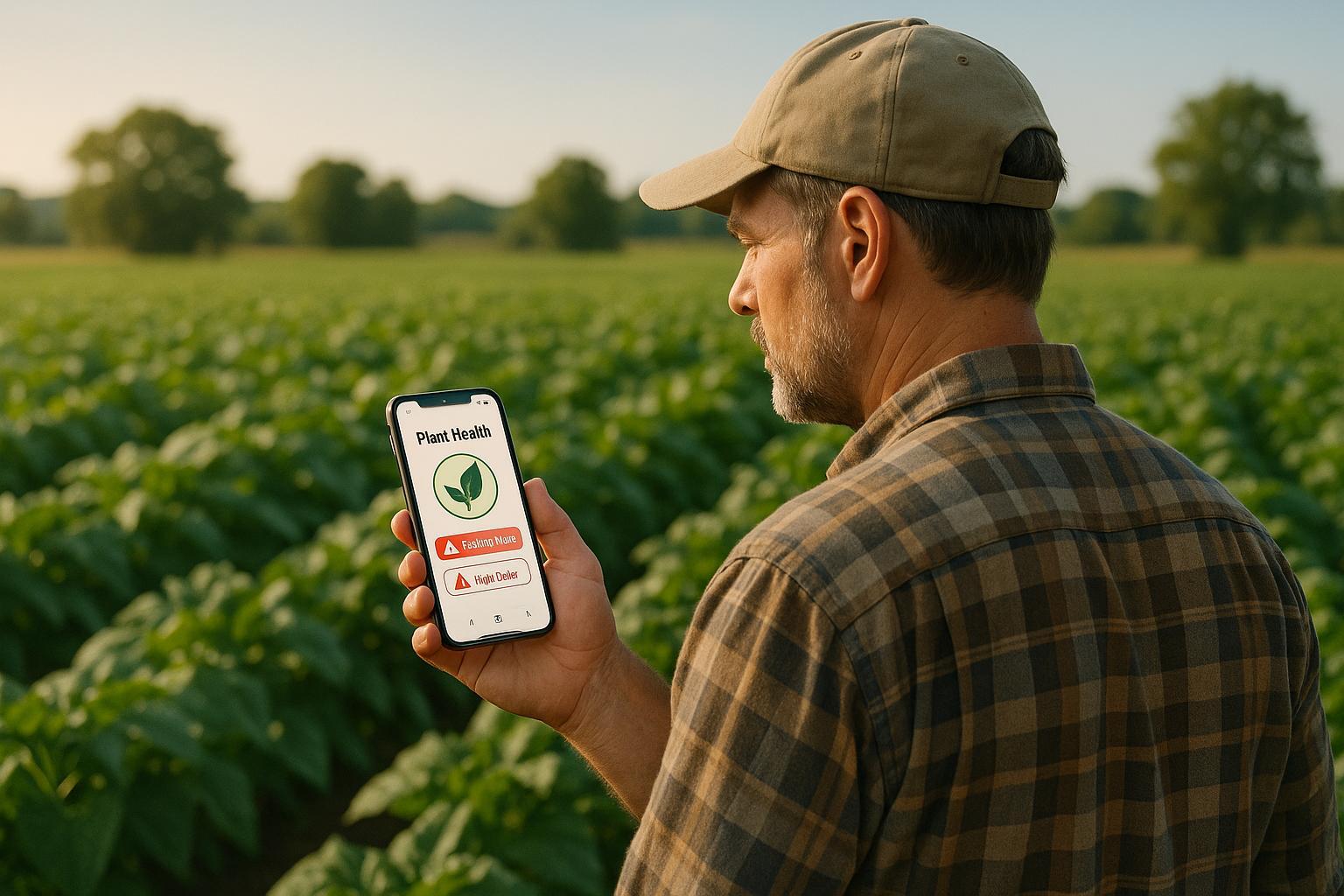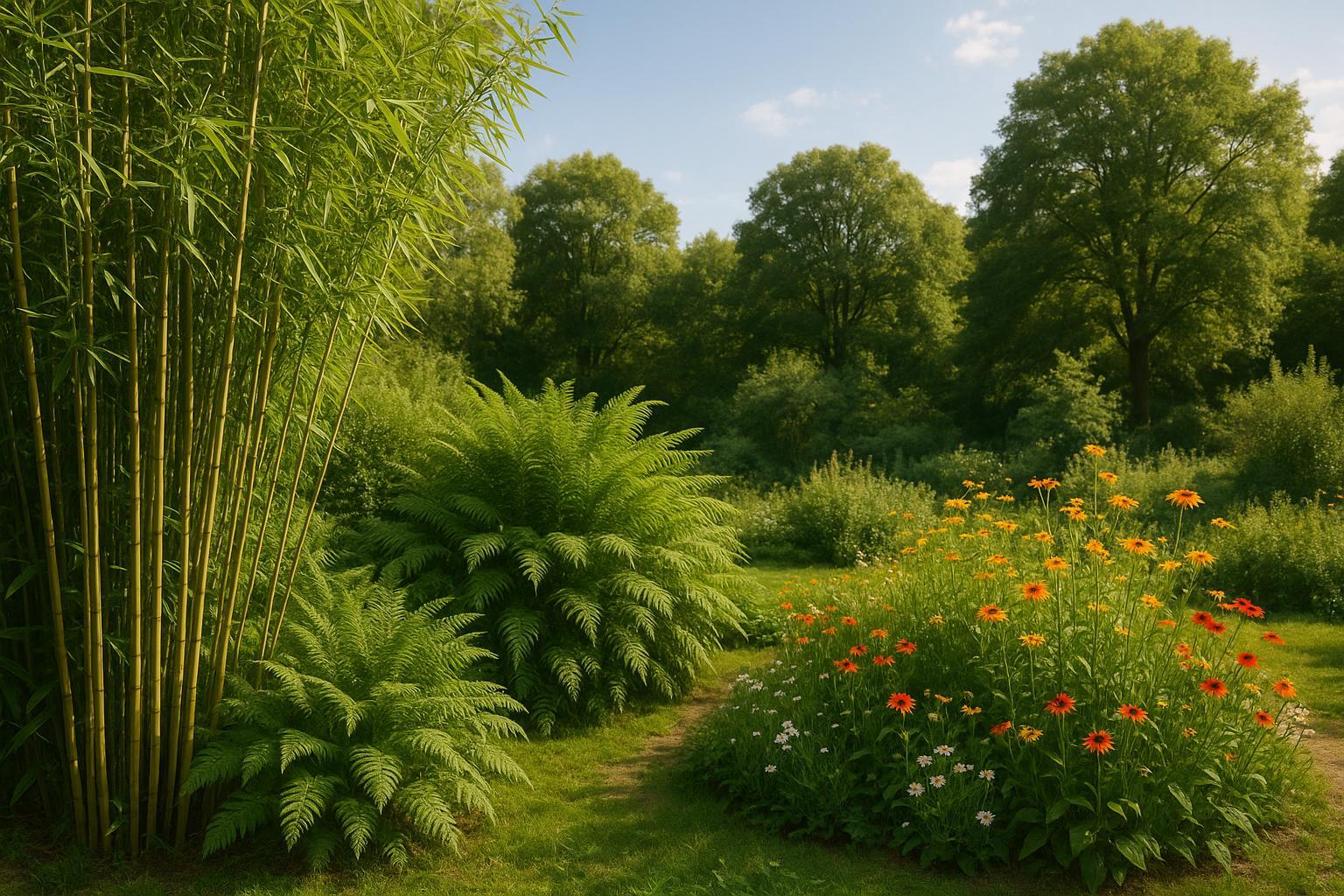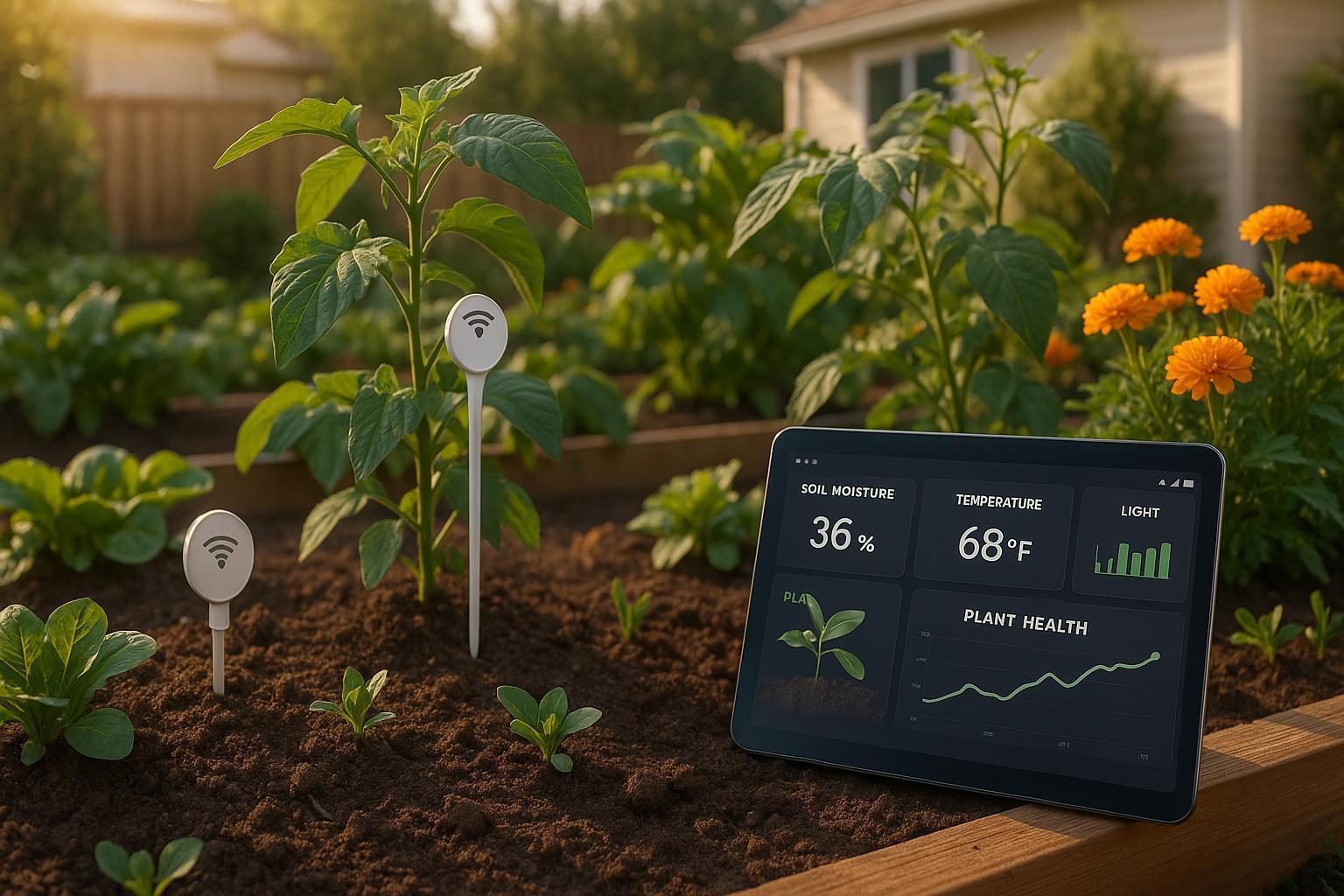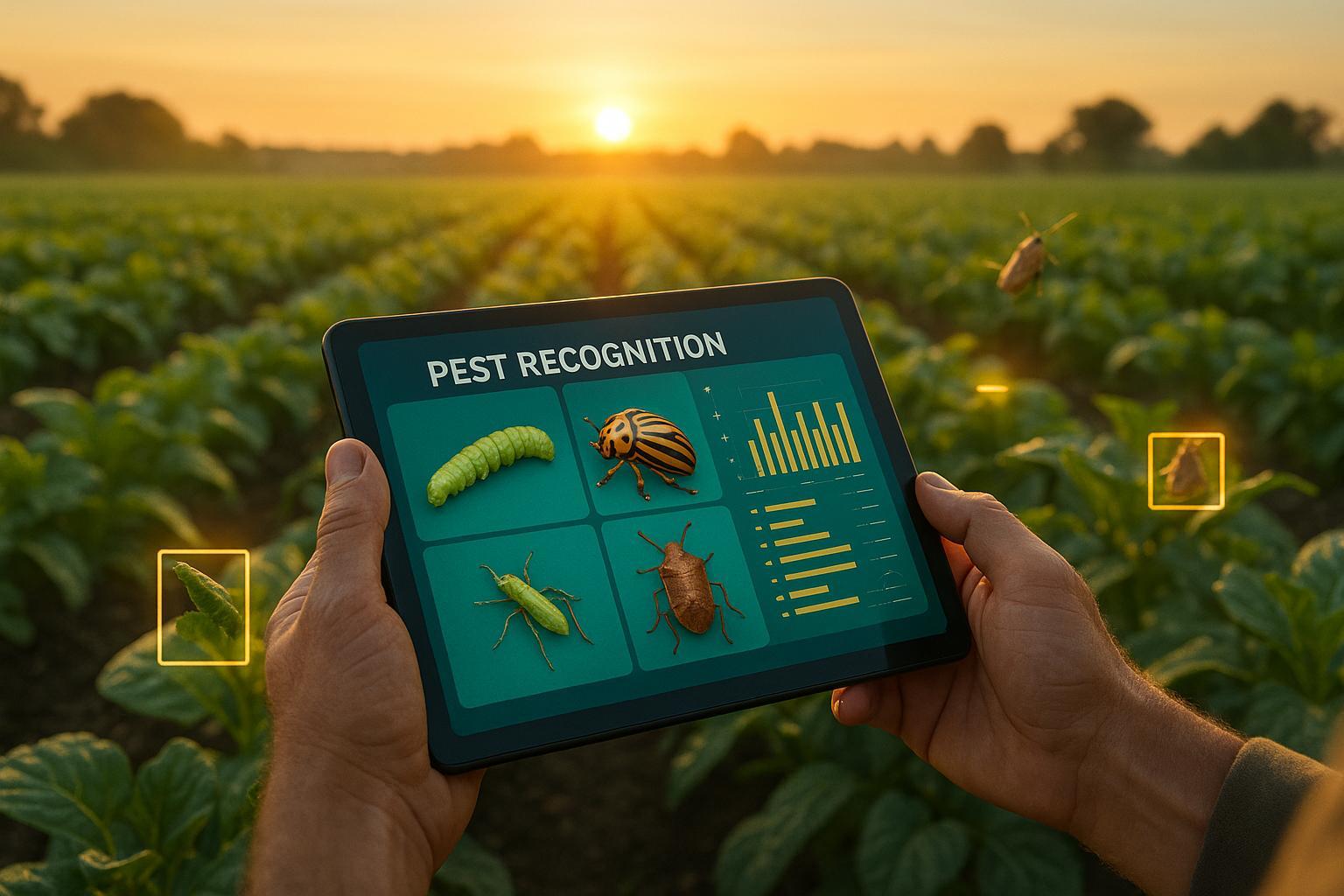AI in Spray Coverage: How It Improves Accuracy

AI is transforming how crops are sprayed, making the process more precise, cost-effective, and environmentally friendly. Traditional methods waste up to 98% of chemicals, harming water sources and increasing costs. AI-powered systems, like John Deere’s See & Spray and AgZen’s REALCOVERAGE, use machine vision and deep learning to target only the necessary areas, cutting chemical use by 50–90% and saving farmers up to $35 per acre.
Key takeaways:
- AI spot spraying reduces herbicide use by up to 90%.
- Farmers report 60–70% savings on chemical costs.
- Precision tools improve crop yields by up to 20%.
- Advanced systems like drones and autonomous sprayers ensure accurate application, reducing drift and waste.
These technologies not only save money but also help farmers comply with environmental regulations and improve overall efficiency in agriculture.
See & Spray AI agricultural robot approaching the speed of sight

AI Technologies That Improve Spray Precision
AI-powered spray precision is built on three key technologies: machine vision, deep learning, and autonomous sprayers. Together, they combine advanced imaging, smart algorithms, and automated machinery to deliver targeted treatments with incredible accuracy.
Machine Vision Systems
Machine vision systems act as the "eyes" of modern spray equipment. Using high-resolution cameras and sensors, these systems scan fields in real-time, pinpointing exactly where treatment is required[4]. With the ability to distinguish between weeds and crops, they rely on features like color, shape, and texture to make precise identifications[6].
One of the standout applications of this technology is in robotic weeders, which have shown remarkable efficiency. These machines can cut herbicide use by up to 95% and reduce the volume of chemicals needed by 20 times compared to traditional methods[4]. For instance, a prototype robotic weeder demonstrated a 96% reduction in inputs and slashed weeding costs by over 50% when compared to conventional approaches[4].
"Robotic weeders are emerging as a tool in modern agriculture, offering innovative solutions to address the challenges of traditional weed control methods."[4]
_ - Lirong Xiang, Assistant Professor and Extension Specialist, Biological & Agricultural Engineering_
Deep Learning Algorithms
Once visual data is captured, deep learning algorithms take over to fine-tune spraying decisions in real time. These AI models analyze the input data and adjust spraying parameters to maximize effectiveness[8].
One standout example is the YOLOv4 model, which has proven highly effective for weed recognition. A December 2024 study in the Journal of Agriculture and Food Research highlighted a machine vision-based spraying system built on this model. Equipped with an FLIR RGB camera and Nvidia Jetson AGX Orin edge device, the system achieved impressive results during testing[5].
- Indoor experiments: Average effective spraying rate of 93.33%, with 100% precision and 92.8% recall.
- Field experiments: Average effective spraying rate of 90.6%, maintaining 95.5% precision and 89.47% recall[5].
Other deep learning models have also delivered outstanding performance. For instance, a robotic sprayer using the MobileNetV2 model achieved 100% accuracy in plant classification[7]. Similarly, a system designed for weed identification in sugarcane fields reached 96.6% accuracy[8].
Advanced techniques like dilated convolutions and adaptive gradient methods have further enhanced the YOLOv8 algorithm, enabling real-time segmentation of fruit tree canopies. The results? An average accuracy of 93.3% and a 40% reduction in spraying waste, making spray coverage both effective and environmentally conscious[8].
Connection with Autonomous Sprayers
The true potential of these technologies shines when paired with autonomous sprayers. These machines seamlessly integrate machine vision and deep learning to execute precision spraying with minimal human involvement.
As the sprayer navigates the field, its machine vision system continuously scans for targets, while deep learning algorithms process the data and adjust spray patterns on the fly. This creates a dynamic feedback loop, ensuring consistent and accurate coverage throughout the operation.
Performance can vary based on crop type and conditions. For example, a study revealed that a robotic sprayer achieved an 87% average spray coverage on lemon foliage, compared to 67% on navel orange. This adaptability highlights how AI systems can adjust to different agricultural scenarios[7].
How to Measure Spray Coverage Accuracy
Improving spray coverage accuracy, especially with AI advancements that cut down on chemical waste, involves using specific metrics to evaluate performance. These measurements help fine-tune pesticide application, saving costs and promoting more sustainable farming practices.
Key Metrics and Results
Spray accuracy relies on four main factors: area coverage, droplet density, droplet diameter, and drift patterns. Additional indicators like the volume median diameter (VMD) and relative span factor (RSF) also assess droplet size and uniformity[9].
A popular tool for measuring coverage is water-sensitive paper (WSP), which changes color when hit by droplets, providing a visual record of spray patterns. AI advancements have taken this method a step further. In one study, researchers combined WSP with machine learning models such as YOLOv8, Mask-RCNN, and Cellpose to analyze spray quality automatically. The results were impressive: YOLOv8 achieved a 97.76% Intersection over Union for segmenting WSP within vegetation, while Cellpose demonstrated 96.18% precision in detecting droplets, even when they overlapped[9]. These metrics pave the way for even more precise imaging techniques to enhance spray accuracy.
Using Drones and Images to Check Coverage
Drones have become a game-changer in monitoring spray coverage. Equipped with GPS, terrain-following radar, LIDAR, and high-precision GNSS, drones ensure accurate flight paths and spraying rates. The crop-spraying drone market, valued at $2.47 billion in 2024, is expected to grow to $3.41 billion in 2025, with a projected value of $10.86 billion by 2029, growing at a compound annual rate of 38.3%[11].
Drone imagery helps identify gaps, overlaps, and drift in spray coverage. This data allows farmers to fine-tune their systems for better performance during future applications. Specialized imaging tools like Swath Kit, USDA Image Analyzer, Droplet Scan, Deposit Scan, ImageJ, and Drop Vision-Ag analyze the distribution and movement of droplets on plant surfaces[10]. When combined with farm management systems, these tools create a feedback loop that enables precise adjustments based on detailed field data[11]. This level of precision highlights the benefits of AI spot spraying compared to traditional methods.
AI Spot Spraying vs. Standard Methods
AI spot spraying offers a more efficient alternative to blanket spraying, which applies chemicals across entire fields. By targeting individual weeds, AI systems significantly reduce chemical use. GPS-enabled technology ensures minimal overlap or missed areas, leading to precise applications.
| Method | Herbicide Reduction | Accuracy Rate | Weed Control Efficiency |
|---|---|---|---|
| AI Spot Spraying | 50–90% | 95%+ | 95%+ |
| Blanket Spraying | Baseline | Low | 65–75% |
AI-powered spot spraying can cut herbicide use by 50–90% while achieving over 95% accuracy and weed control efficiency[1][13]. Real-world tests back up these findings. For example, spot spraying on sugarcane farms achieved 97% of the effectiveness of broadcast spraying while reducing herbicide use by 35%. Under lower weed pressure, reductions reached as high as 65%[12].
These advancements not only lower costs per acre but also reduce environmental impacts by applying chemicals only where they are needed, making farming practices more efficient and eco-friendly.
sbb-itb-4d6a8dd
🚀 Ready to Reinvent Your Garden?
Join thousands of homeowners who have transformed their gardens using our AI design tool. Upload one photo to explore endless possibilities.
Get your AI garden designs →Real Examples of AI Spray Systems
AI spray systems are no longer just a concept; they're actively being used on farms across the United States, delivering measurable results. Let’s take a closer look at how these systems are making a difference in agriculture.
John Deere See & Spray Technology
John Deere's See & Spray technology is one of the most widely used AI spray systems in the U.S. It uses advanced AI-driven vision and processing to detect and target weeds in real-time, making spray decisions in just milliseconds [3][16].
"The system integrates AI and boom-mounted cameras. The vision processing units provide real-time data, and the system determines whether each element is a weed or a crop. If it spots a crop, it activates a nozzle and sprays the weed. All of this occurs within milliseconds."
_ - Mark Schaffner, RDO Equipment Co. regional sales manager_ [3]
John Deere offers three versions of this system to suit different farming needs:
- See & Spray Select: Designed for fallow ground, it uses color-detection technology with a single tank system.
- See & Spray Premium: Handles both in-season and fallow applications, distinguishing crops from weeds.
- See & Spray Ultimate: The most advanced version, equipped with high-tech cameras and dual product tanks for in-season use in crops like corn, soybeans, and cotton [14][16][17].
The results speak for themselves. Iowa State University reported 76% herbicide savings, which translates to $15 per acre when using this equipment [15]. Beck's Hybrids found even greater savings, reporting $24 per acre saved along with a yield boost of over 4 bushels per acre [15]. Across more than one million acres, farmers using See & Spray technology saw an average savings of 59% [15].
"I learned that your fields are very predictable. After you look at a See & Spray coverage map, you can see a tree row removed 10 years ago, or the perimeters of your fields are heavier in weed density. All this info helps me to make informed decisions about spraying."
_ - Jared Billadeau, North Dakota grain farmer_ [3]
The system's precision is enhanced by BoomTrac Ultimate, which ensures the boom tip stays within 10 inches of the target height 95% of the time, reducing drift and ensuring accurate spray placement [14]. Other companies, like Bosch and BASF, are achieving similar levels of precision with their systems.
Bosch & BASF's One Smart Spray System
The ONE SMART SPRAY system combines Bosch's expertise in hardware with BASF's knowledge of agronomy to create a dual-tank precision solution. Using cameras, it identifies weeds and applies herbicide only where needed, even in low-light conditions [18][19].
"ONE SMART SPRAY is the realization of a value proposition like no other available to farmers today. The camera-based system developed by Bosch detects weeds in milliseconds and precisely sprays only where necessary and only as much as needed."
_ - Konstantin Kretschun, Co-Managing Director of ONE SMART SPRAY_ [18]
This system delivers up to 70% herbicide savings while maintaining the effectiveness of broadcast spraying [19][20]. Unlike retrofit options, ONE SMART SPRAY is integrated directly into sprayers during manufacturing, ensuring smooth operation [20].
The technology was showcased in the AGCO Fendt Rogator at the 2023 Farm Progress Show, following its recognition as the Showstopper Award winner at the 2023 MAGIE Show in Illinois [21]. This collaboration highlights how major players are embracing AI in agriculture.
"Our purpose is to get a better efficacy of false negatives. What I mean by false negatives is if the sprayer missed the weed. We understand that from the farmer's point of view, we have no room for error. The lighting will help keep that false-negative down to a minimum."
_ - Matt Leininger, managing director for North America for the new Bosch BASF joint venture_ [19]
The system also generates detailed application maps, showing exactly where herbicide was used, which helps farmers create long-term strategies for weed management [19].
Field Results from Midwest and Northwest Regions
Field research across the Midwest and Northwest has revealed how AI-powered systems outperform traditional methods. For example, UAV-based spray systems in Midwest cornfields produced droplet sizes of 179 and 112 micrometers, compared to 303 and 423 micrometers from traditional sprayers [22]. Smaller droplets mean more even coverage, with UAV systems reducing vertical coverage variation to 25–27%, while traditional methods saw 54–61% variation [22].
In commercial nurseries, laser-guided variable-rate sprayers achieved 60% to 77.6% reductions in spray volume and chemicals while maintaining effective pest control. Specific trials showed 36% less chemical use for Prairifire crabapple and 30% less for Honey locust [23].
Drift analysis further highlights the advantages of AI systems. At 10 meters from the field edge, UAV trials showed no increase in small particle concentrations, while traditional methods saw increases of 73% and 88%, respectively [22].
| System Type | Droplet Size (μm) | Coverage Uniformity | Drift at 10m | Chemical Reduction |
|---|---|---|---|---|
| AI UAV Systems | 112-179 | 25-27% variation | 0% increase | 60-77.6% |
| Traditional Implement | 303-423 | 54-61% variation | 73-88% increase | Baseline |
These results illustrate how AI systems are reshaping spray coverage across diverse farming landscapes, offering precision, efficiency, and environmental benefits.
Future of AI-Powered Spray Coverage
AI-driven spray systems are no longer experimental gadgets - they’re becoming indispensable tools in U.S. agriculture. By improving accuracy and reducing chemical waste, these systems are transforming farming practices.
Industry Standards and Adoption
Precision spraying is already in use on more than 60% of modern U.S. farms, helping to cut chemical waste and boost crop yields [25]. The market for AI in agriculture is projected to grow from $1.7 billion in 2023 to $4.7 billion by 2028 [24]. Autonomous sprayers, which can improve efficiency by 50–65% [25], typically cost between $150,000 and $650,000 [25]. While the upfront investment is significant, the returns - lower labor costs, reduced chemical use, and higher yields - make it worthwhile for many farmers.
The falling costs of computer vision and robotics are also speeding up adoption [24]. Companies like CarbonRobotics are leading the charge with innovations like their laser weeder, which uses AI and computer vision to detect and destroy weeds in real time. The company raised $70 million in 2024, with backing from Nvidia’s venture capital arm [26]. Similarly, Plantix is leveraging AI to diagnose crop diseases through photo analysis and recommend tailored solutions [26].
These advancements are setting the stage for even deeper integration with farm management technologies.
Integration with Farm Management Software
Connecting AI spray systems with digital farm management platforms offers farmers a bird’s-eye view of their entire operation. This integration ties spray decisions to crop health, yield tracking, labor efficiency, and regulatory compliance [29][30]. Platforms like Farmable demonstrate how this connectivity can improve efficiency by up to 30% [27]. Features such as task delegation, progress tracking, and detailed documentation feed AI systems with valuable data, enabling smarter recommendations for optimizing inputs and minimizing waste [30].
Farmers are already seeing the benefits. Over 70% of those using AI report better crop health monitoring and faster data analysis [27]. Sarah Schinckel, director of emerging technologies at John Deere’s Intelligent Solutions Group (ISG), puts it simply:
"Our goal with AI and technology is to help farmers do their jobs better" [28].
The key to success lies in selecting AI tools that integrate smoothly with existing equipment and management systems while ensuring a strong data infrastructure [29]. This integration also supports compliance with environmental regulations, a growing priority for the agricultural sector.
Environmental Compliance and Sustainability
AI spray systems are becoming essential for meeting environmental regulations and advancing sustainability goals. By monitoring pollution and analyzing data in real time, these tools help farmers comply with laws like the Clean Air and Water Acts, reducing the burden of inspections [31].
The business case for compliance is clear: 73% of companies are already using AI for analytics and generative tasks, and 72% of top CEOs believe staying competitive depends on adopting advanced AI [32]. AI-powered sensors and analytics tools provide continuous monitoring of factors like water quality, issuing alerts for violations and supporting public health initiatives [31].
As Dr. Sri Amit Ray notes:
"AI plays a pivotal role in sustainability, energy recycling, and pollution prevention" [31].
Looking ahead, global AI standards are beginning to take shape, which could influence how the technology is governed in the U.S. and beyond [32]. Farmers are encouraged to set clear goals, stay informed about evolving regulations, and keep an eye on international developments [33].
Conclusion: AI's Impact on Spray Coverage Accuracy
AI technology has reshaped how spray coverage is managed in U.S. agriculture, offering tangible benefits that go far beyond just saving money. For example, AI-powered spot spraying can reduce herbicide use by up to 90% while maintaining an impressive 95% accuracy in targeting weeds [1].
Farmers can save up to $35 per acre by cutting herbicide usage by 75%, and this targeted approach can also increase crop yields by as much as 20% [2] [34]. Research into crop intelligence shows that AI digital scouting delivers a first-year return on investment that's three times higher [34]. This financial advantage comes from AI’s ability to work with unmatched speed and precision.
AI systems rely on onboard computers and machine vision to make split-second decisions about spraying, significantly reducing issues like drift and overspray [1]. These systems analyze data in real time and direct advanced nozzles to apply the exact amount of herbicide needed, only where it’s needed. This precision not only cuts costs but also reduces chemical runoff and soil contamination, helping farmers meet stricter environmental regulations [1].
Looking ahead, advancements in edge computing, 5G, and robotics could increase global crop yields by up to 30% and cut water usage by 20% by 2025 [35]. This shows how AI is paving the way for smarter, more efficient farming.
AI spray technology isn't just a step forward - it's a game changer for modern agriculture. For U.S. farmers, it represents a shift toward precision farming that delivers immediate results while setting the stage for sustainable and profitable farming practices in the future.
FAQs
How do AI technologies like See & Spray and REALCOVERAGE help farmers save on chemicals and costs?
AI-driven tools like John Deere's See & Spray and AgZen's REALCOVERAGE are transforming agriculture with cutting-edge technologies like machine vision and deep learning. See & Spray can reduce herbicide use by an impressive 60–70% by accurately identifying and targeting weeds. Similarly, REALCOVERAGE optimizes spray patterns, cutting chemical use by as much as 50%.
These advancements help farmers save money while supporting more sustainable farming by reducing waste and limiting the impact on the environment.
How do machine vision and deep learning improve spray coverage accuracy in agriculture?
Machine vision and deep learning technologies are transforming how spray coverage is managed in agriculture. These tools allow for highly accurate weed identification, real-time monitoring of droplet movement, and fine-tuned spray patterns. By analyzing plant structures and environmental factors, these systems ensure that sprays are applied exactly where they're needed - cutting down on waste and boosting efficiency.
With these AI-powered solutions, farmers can apply treatments more precisely, use fewer chemicals, and support healthier crop development, all while lowering the impact on the environment.
How do AI-powered spray systems support sustainable farming and environmental protection?
AI-powered spray systems are transforming farming practices by making them more efficient and environmentally friendly. These systems precisely apply pesticides, fertilizers, and other chemicals, cutting chemical use by as much as 70%. This not only helps maintain soil health but also safeguards water quality and supports local ecosystems.
By reducing runoff and waste, these systems contribute to preserving biodiversity and lowering the environmental impact of agriculture. On top of that, AI technology fine-tunes water usage, ensuring farming becomes more resource-efficient while staying eco-conscious.
🎨 Visualize Your Dream Garden Today!
Transform any outdoor space into a professional landscape design in minutes. Just upload a photo, choose your style, and let our AI do the rest.
Start your garden transformation now →Related posts
Related Articles

How Mobile Alerts Help Prevent Plant Disease Spread
Mobile alert systems revolutionize plant disease prevention by providing real-time monitoring and tailored alerts for gardeners and farmers.

Top Plants for Carbon Sequestration
Explore how selecting the right plants for your garden can enhance carbon sequestration, support local ecosystems, and promote sustainability.

IoT Data Collection for Climate-Specific Gardening
Explore how IoT technology revolutionizes gardening by optimizing resource use, predicting diseases, and enhancing plant health for sustainable practices.

AI Datasets for Pest Recognition: Explained
Explore how AI datasets enhance pest recognition in agriculture, tackling challenges and leveraging synthetic data for improved crop management.

The Ultimate Guide to Drainage in Raised Garden Beds
Discover the importance of drainage in raised garden beds and learn how to provide effective drainage for optimal plant growth. Find out why proper drainage is essential and the consequences of poor drainage.

How AI Sensors Improve Seasonal Plant Monitoring
Explore how AI sensors revolutionize plant monitoring, enhancing resource efficiency, boosting yields, and enabling early disease detection.